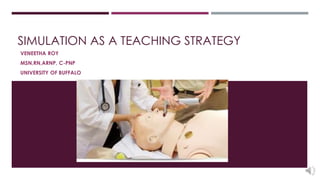
SIMULATION AS A TEACHING STRATEGY
- 1. SIMULATION AS A TEACHING STRATEGY VENEETHA ROY MSN,RN,ARNP, C-PNP UNIVERSITY OF BUFFALO
- 2. INTRODUCTION Patient simulation offers nursing students with varied clinical patient experiences Comparable to that of an acute setting. Conventional nursing emphasizes on memorization Nurse educators are now increasingly looking up to simulation for provision of high acuity patient care experience in a risk free, controlled learning environment (Katz, Peifer, & Armstrong, 2010). Simulation is being used by nursing educators to enhance learning outcomes and promote safety of the patients, (Billings & Halstead, 2012).
- 3. DEFINITION OF SIMULATION Simulations provide the opportunity for students to think critically, problem solve, use clinical reasoning and care for diverse patients in a non-threatening, safe environment,”(Seropian, 2003). Simulation utilizes a clinical scenario which involves a student or a group of students providing care to a patient which is usually a mannequin, an actor or a standardized patient in a realistic clinical environment ,” (Jeffries, 2012).
- 4. DESCRIPTION & USES The use of human patient simulators (HPSs) has become common practice and simulation based pedagogy allows students to integrate psychomotor skill performance, critical thinking, clinical judgment and communication skills while gaining confidence in the clinical setting and also offers an opportunity for assessment and remediation of skills and continued learning, (Durham & Alden, 2010). Various organizations have recognized its value as a teaching technique including the Commission on Collegiate Nursing Education (CCNE), National League for Nursing (NLN), NCSBN etc. There are different levels of sophistication and a variety of simulators are available for creation of simulation scenarios. Simulators can be categorized according to fidelity and how closely it represents a realistic situation.
- 5. ROLE OF INSTRUCTOR & STUDENT Simulations offer flexibility and can assist with students educational needs. It can be accessed in a safe environment for practice and mastering clinical skills with or without an instructor’s presence, (Billings & Halstead 2012). Instructors can be present for extra instruction or reinforcement. Simulation can facilitate the learning of clinical skills and measure skill competency before taking students to the clinical unit.
- 6. BENEFITS/ADVANTAGES The major benefits of clinical simulation include a consistent and standardized experience for all. One major advantage of concept mapping is that it can be used in various settings and populations. The nursing student can access the simulation according to their own schedule which gives the benefit of flexibility. Student instruction is improved and there is increased consistency in the material being taught. Learner satisfaction is increased as the students can practice high acuity patient care in safe, non- threatening environments.
- 7. BARRIERS Most of the challenges center on nursing educator preparation. Nursing faculty should be trained well in the art and science of simulation as without groundwork, Simulation can be hard to implement. It is important to have clear learning objectives when one undertakes a simulation scenario as it is easy to feel overwhelmed and lose focus on what the learner outcomes should be. Adequate time needs to be provided to the learner to experience simulation, reflect upon the experience and understand feedback provided so that the learning objectives of the simulation can be met. There is time that needs to be taken to teach and to learn how to develop and properly use simulation
- 8. EFFICACY After reviewing the literature, Adler et al concluded that acute care event management skills such as identification of pediatric sepsis can be objectively evaluated using patient simulation (Adler et al., 2007). The study concluded that simulation could be used to measure and enhance resident competencies in acute care management of cases such as Sepsis, Apnea, Asthma and Supraventricular Tachycardia. According to Nishisaki et al, a simulation training for first year Pediatric Critical Care fellows was organized by seven institutions and high-fidelity simulation was utilized for airway management, vascular access, resuscitation, sepsis, trauma/traumatic brain injury, delivering bad news. A survey at the end of the program revealed that the training helped enhance clinical performance and self-confidence in diagnostic ability of those participating (Nishisaki et al., 2009).
- 9. REFERENCES Adler, M.D., Trainor, J.L., Siddall, V.J., McGaghie,W.C., (2007). Development and evaluation of high-fidelity simulation case scenarios for pediatric resident education. Ambulatory Pediatrics, 7(2), 182-186. Billings, D. M., & Halstead, J. A. (2012). Teaching in nursing: a guide for faculty. St. Louis, Mo.: Elsevier/Saunders. Brannan, J. D., White, A., & Bezanson, J. (2008). Simulator effects on cognitive skills and confidence levels. Journal of Nursing Education, 47(11), 495–500. Durham,C.F., & Alden, K.R.(2010). The nuts and bolts of using simulation. In L. Caputi (Ed.), Teaching nursing: The art and science, Glen Ellyn,IL: College of DuPage Press, 28-55. Gaberson, K. B., Oermann, M.H., Campbell, S.H., (2010). Clinical teaching strategies in nursing. New York, Springer Publishing Company. Jeffries, P.R. (2012). Simulation in nursing education: From conceptualization to evaluation (2nd ed). New York,NY: National League for Nursing. Katz, G. B., Peifer, K. L., & Armstrong, G. (2010). Assessment of patient simulation use in selected baccalaureate nursing programs in the United States. Simulation in Healthcare, 5(1), 46–51. Nishisaki, A., Hales, R., Biagas, K., Cheifetz, I., Corriveau, C., Garber, N., Hunt, E., Jarrah, R., McCloskey, J., Morrison, W., Nelson, K., Niles, D., Smith, S., Thomas, S., Tuttle, S., Helfaer, M., Nadkarni V. (2009). A multi-institutional high-fidelity simulation "boot camp" orientation and training program for first year pediatric critical care fellows. Pediatric Critical Care Medicine, 10(2), 157-162. doi: 10.1097/PCC.0b013e3181956d29. Scherer, Y., Bruce, S., Graves, B., Erdley, W., (2003). Acute care nurse practitioner education: Enhancing performance through the use of clinical simulation. AACN Clinical Issues: Advanced Practice in Acute & Critical Care, 14,331–341. Seropian, M. (2003). General concepts in full scale simulation: Getting started. Anesthesiology and Analgesia, 97(6), 1695– 1705.